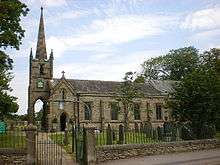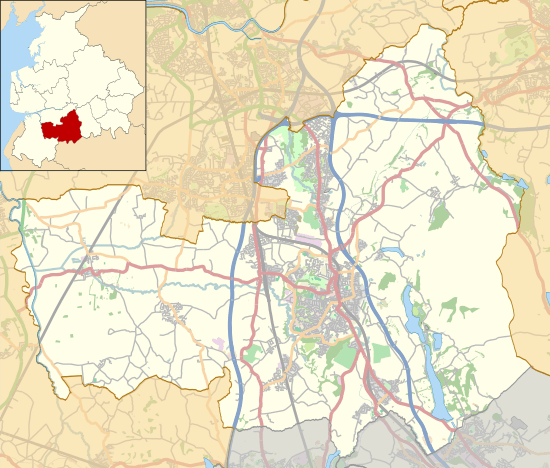St John the Baptist's Church, Bretherton
St John the Baptist's Church is in the village of Bretherton, Lancashire, England. It is an active Anglican parish church in the deanery of Chorley, the archdeaconry of Blackburn and the diocese of Blackburn. Its benefice is united with that of St Michael and All Angels, Croston.[1] The church is recorded in the National Heritage List for England as a designated Grade II listed building.[2] It was a Commissioners' church, having received a grant towards its construction from the Church Building Commission.[3]
| St John the Baptist's Church, Bretherton | |
|---|---|
 St John the Baptist's Church, Bretherton, from the south | |
 St John the Baptist's Church, Bretherton Location in the Borough of Chorley | |
| OS grid reference | SD 476,204 |
| Location | Bretherton, Lancashire |
| Country | England |
| Denomination | Anglican |
| Website | St John the Baptist, Bretherton |
| History | |
| Status | Parish church |
| Founded | 1839 |
| Dedication | St John the Baptist |
| Consecrated | July 1840 |
| Architecture | |
| Functional status | Active |
| Heritage designation | Grade II |
| Designated | 30 January 1987 |
| Architect(s) | Edmund Sharpe Austin and Paley |
| Architectural type | Church |
| Style | Gothic Revival |
| Groundbreaking | 1839 |
| Completed | 1909 |
| Construction cost | £1,058 (£100,000 in 2019) |
| Specifications | |
| Materials | Sandstone, slate roofs |
| Administration | |
| Parish | Bretherton |
| Deanery | Chorley |
| Archdeaconry | Blackburn |
| Diocese | Blackburn |
| Province | York |
| Clergy | |
| Rector | Revd D. J. Reynolds |
| Laity | |
| Reader(s) | Miss J. Maggs, Stanley Hazlewood |
| Organist(s) | Mrs Lesley Moulton |
| Churchwarden(s) | John Hart, Sheila Williams |
History
St John's was a Commissioners' church costing £1,058 (equivalent to £100,000 in 2019).[4] The Church Building Commission contributed £250 towards its cost.[3] It was designed by the Lancaster architect Edmund Sharpe and built in 1839–40.[5] The land was given by George Arthur Legh Keck. The church provided seating for 400 people.[3] In July 1840 it was consecrated by Rt Revd John Bird Sumner, at that time the Bishop of Chester.[5] The church was restored in 1898 by Sharpe's successors Austin and Paley,[6] who also added a chancel and vestry in 1908–09.[7] In September 2009 the church was damaged by fire caused by an arsonist.[8]
Architecture
The church is constructed in sandstone with slate roofs. Its plan consists of a five-bay nave incorporating a south porch, and a two-bay chancel under a higher roof. The style of the nave is "simple Gothic", while that of the chancel is Perpendicular. At the west end is a slender tower, the lowest stage of which constitutes a porch that is open on three sides. Above this are three string courses, the top one of which is stepped over the bell opening. At the corners are buttresses that rise to form crocketted pinnacles. At the top of the tower between the pinnacles is a stepped parapet. A slim octagonal spire rises from the tower. The porch has an arched doorway over which is a lancet window. Its top is gabled and has a cross finial. The east window has five lights and Perpendicular tracery. Inside the church is a west gallery supported on four slim iron columns.[2] The two-manual organ was built by Ainscough Organ Builders of Preston in 1929, and rebuilt and extended by David Wells of Liverpool in 2000.[9]
External features
The churchyard contains the war grave of a Loyal Regiment soldier of World War I.[10]
See also
- Listed buildings in Bretherton
- List of architectural works by Edmund Sharpe
- List of ecclesiastical works by Austin and Paley (1895–1914)
- List of Commissioners' churches in Northeast and Northwest England
Gallery
 Interior – view towards altar
Interior – view towards altar Interior – view towards rear
Interior – view towards rear The font
The font Clock
Clock Stained glass window
Stained glass window The organ
The organ
References
| Wikimedia Commons has media related to St John the Baptist's church, Bretherton. |
Citations
- St John the Baptist, Bretherton, Church of England, retrieved 27 July 2011
- Historic England, "Church of St John the Evangelist, Bretherton (1362115)", National Heritage List for England, retrieved 27 May 2012
- Brandwood et al. (2012), p. 211
- UK Retail Price Index inflation figures are based on data from Clark, Gregory (2017), "The Annual RPI and Average Earnings for Britain, 1209 to Present (New Series)", MeasuringWorth, retrieved 2 February 2020
- Hughes (2010), p. 138
- Brandwood et al. (2012), p. 242
- Brandwood et al. (2012), p. 247
- Johnson, Mark (1 October 2009), "Yobs destroy pulpit at John the Baptist Church in Bretherton and St Michael's CE Church in Much Hoole", Ormskirk Advertiser, Ormskirk: Trinity Mirror North West & North Wales, retrieved 3 April 2010
- Lancashire, Bretherton – St. John the Baptist, British Institute of Organ Studies, retrieved 3 April 2010
- BRETHERTON (ST. JOHN THE BAPTIST) CHURCHYARD, Commonwealth War Graves Commission, retrieved 13 February 2013
Sources
- Brandwood, Geoff; Austin, Tim; Hughes, John; Price, James (2012), The Architecture of Sharpe, Paley and Austin, Swindon: English Heritage, ISBN 978-1-84802-049-8
- Hughes, John M. (2010), Edmund Sharpe: Man of Lancaster, John M. Hughes
